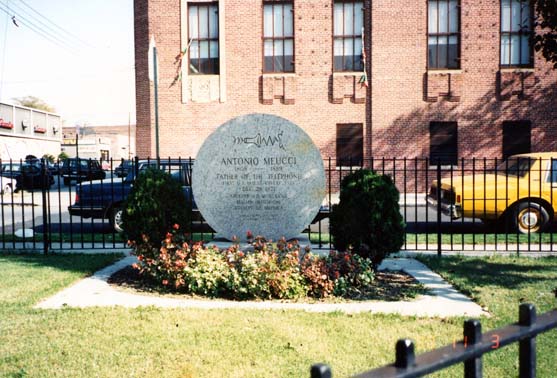
Basilio Catania's Work on the History of the Telephone
1. The beginnings of my research (1989-1994): many doubts and hard work . . .
My work on the history of the telephone was originated from a brief investigation I made in 1989, a few months before my retirement, on the merits of Antonio Meucci in the invention of the telephone. I thought that I would spend in that investigation no more than a few weeks and that I would possibly write a 10-page paper. Instead, I worked on it for more than fifteen years, I wrote two books—a first two-volume 1200-pages book and a second of about 400 pages—and dozens of papers and lectures. Still now (year 2010), I occasionally touch again on the matter, following invitations to lecture or to write a paper, or merely to meet with requests of clarifications by scholars. I will try to recall how could that happen.
It all began in the spring of 1989, when a journalist of my acquaintance asked me what we (telecommunications people) had in mind for celebrating the 100th anniversary of Antonio Meucci’s death, occurred in Staten Island, NY, on October 19, 1889. At that time (1989) I personally knew many important persons among the Italian organizations operating in the telecommunications field (manufacturers, service providers, universities and professional societies). Thus, I wrote a letter to them, to inquire whether anyone had notice of or ideas for celebrating that anniversary. Answers were negative, including those from Florence, where Meucci was born. It therefore appeared to me that, in Italy, only the journalists had an interest. This was not the case with the USA, where Italian-Americans of New York were going to amply celebrate that event (see photo below). Among them was a scientist from Comsat Laboratories, Washington, DC (also a consultant of my company), Prof. Pier Luigi Bargellini, a native of Florence, who offered me his help as a liaison with appropriate persons in the United States.

Monument to Antonio Meucci "Father of the Telephone" in Meucci Square, Brooklyn, NY, unveiled on 10 April 1989 by the Italian Historical Society of America.
At that time, my knowledge about Meucci was superficial. I only knew that he was a Florentine immigrated to the USA and that he had something to do with the invention of the telephone. However, I imagined that his contribution to the telephone should not have been so important, as everybody acknowledged Alexander Graham Bell as the first inventor of the telephone. I must add that in my thirty-seven years’ work as a researcher in telecommunications I had learned a lot from the Bell Laboratories, where I could also count many friends, often met in international congresses. Hence, I was pretty inclined to believe that Bell must have deserved that fame, since such a wonderful organization had stemmed from his intuition and pioneering work. So … what about Meucci?
Although my profession as a researcher had always imposed me never to take anything for granted—not even that which has been a credo for centuries— I was short of time and I could not afford to do any research on Meucci. However, I was curious to understand why such many important Italian organizations had decided (or happened) not to get involved in any celebration concerning his contribution to the telephone invention. To explore this, I entrusted the librarian of the organization where I was working (CSELT, Center of Studies and Laboratories of Telecommunications, the equivalent of Bell Laboratories in Italy) to find for me some literature, just to get a rough idea on the matter. A few days later, he came to my office and put a pile of books and magazines on my desk. He then disappeared without a word, not before displaying an enigmatic smile towards me. I just shouted behind him: “Do you think that I’ll go through all that?”
At any rate, I brought the pile at home to browse through it during the next weekend. To my surprise, I found that Guglielmo
Marconi, during his presidency of the Italian National Research Council (CNR),
from 1927 to 1937, strenuously fought to uphold Meucci's merits. I learned that Marconi had first entrusted a law scholar, Dr.
Francesco Moncada, also a teacher of Italian Language at the Columbia University in
New York City, to investigate in the USA about Meucci’s story, and that, following
Moncada’s report, he made publish a 130-page book by the CNR, on “The Telephone and the Priority of Antonio Meucci” [1].
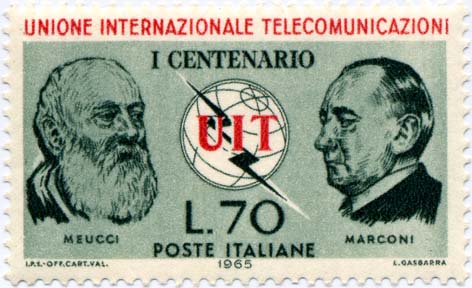
Marconi and Meucci jointly honored on the occasion of the Centenary of the International Telecommunications Union (ITU).
At the same time, Marconi commissioned the Florence’s Galileo Laboratories to reconstruct the two most important Meucci’s telephone models (dated 1857 and 1867 respectively), to be sent to the International Exhibition “A Century of Progress” in Chicago, IL [2]. This Exhibition was held in the month of March 1933, and the Italian pavilion at that exhibition displayed said two Meucci’s telephones along with an enlarged photograph of a page of The Chicago Tribune, dating back to 1885, recounting the “true” story of Meucci’s invention, as seen by his supporters and in line with Moncada’s findings [3]. Finally, as reported by Frances Winwar, Marconi sailed to the USA to visit Meucci’s homestead (now “Garibaldi-Meucci Museum”) in Staten Island, and there he “stood uncovered before it” [4].
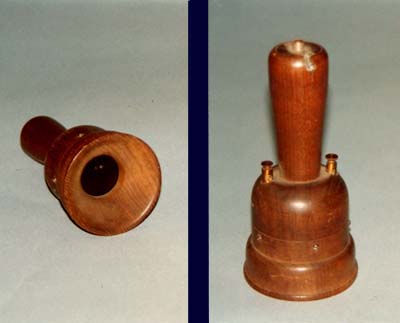
One of the two models of Meucci’s telephones (1857), reconstructed by
Galileo Laboratories in 1933 upon instructions by
Marconi.
Both statements, however, were
harshly criticized, not merely from Meucci’s supporters, but even from the Government of the United States.
Yet, the major opponent of Alexander Graham Bell and the Bell Company was the Government of the United States, who finally summoned both of them to the Courts. This latter trial, known as the “US vs. Bell trial” [8], had been neglected by Schiavo, who meritoriously concentrated his efforts on the Bell vs. Globe trial. The findings relating to the US vs. Bell trial were the major outcome of my research, and showed that this trial was, in some respects, even more important than the former, despite the fact that its (manuscript or typescript) records were never printed and were difficult to find even in the U.S. National Archives.
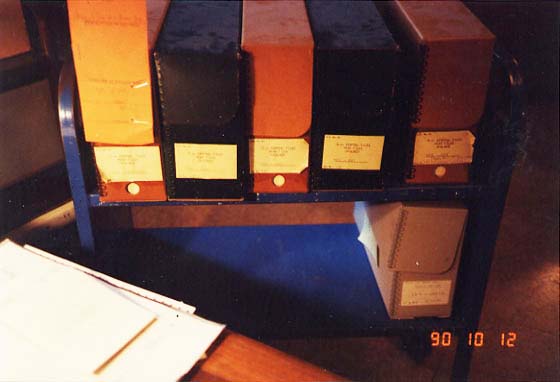
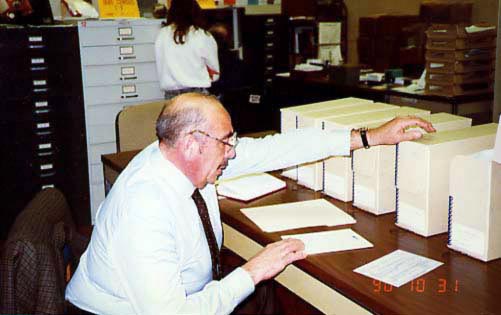
Folders retrieved at the National Archivesin Washington, DC (at left) and in Bayonne,NJ (at right).
It took me four years before organizing and examining in detail those papers (in addition to the many others retrieved in New York), pertaining either to the U.S. Department of Justice or to the U.S. Department of the Interior (to the latter of which reported the Patent Office). I also thought advisable to type a good part of the manuscripts and scan them, together with typescripts and printed documents, and put everything on the hard disk of my computer to facilitate future search.
Briefly, I discovered the following:
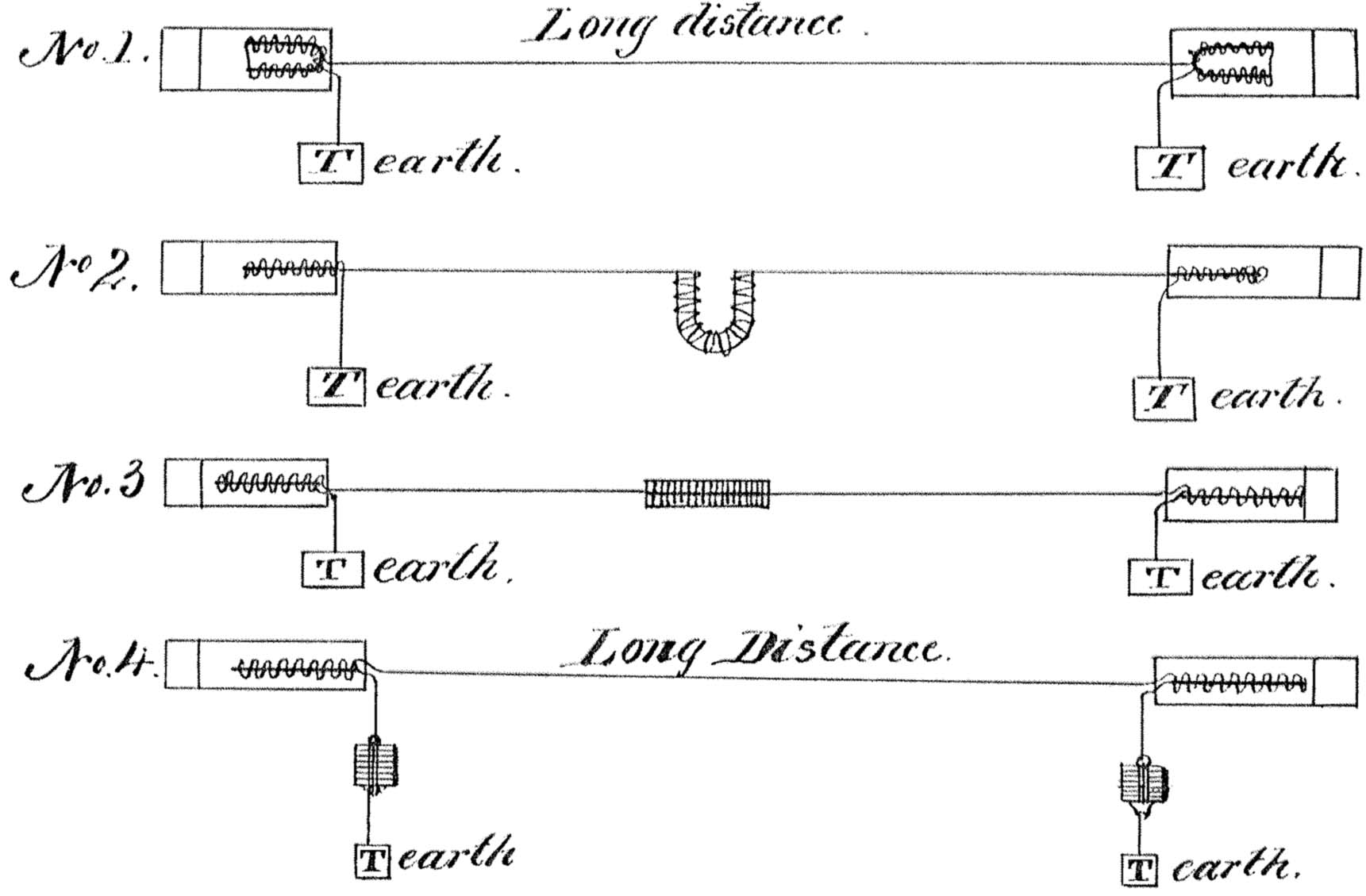
Meucci's drawing of his experiments on inductive loading, dated 27 September 1870.
I rejected the charge of forgery in Meucci's Memorandum Book, as raised by a lawyer of the Bell Company [13], because, even admitting that the date of 27 September 1870, set by Meucci for this experiment, would be fake, the date of 28 September 1885 of the affidavit sworn by Michael Lemmi before a Notary Public of New York is legally certified and precedes anyway that of Pupin's patents by about fifteen years. Moreover, the dates marked by Meucci in his preceding and subsequent notes correspond to ascertained facts, such as his patents filed with the US Patent Office. I then concluded that, despite I had seldom found in the history of science such an advanced vision as Meucci's (except of geniuses like Leonardo da Vinci and few others), Antonio Meucci was tens of years ahead of other telephone inventors.
Also noteworthy in Meucci's Memorandum Book, as notarized by Michael Lemmi, is another drawing, reproduced here at right, giving the typical structure of his telephone much more in detail than the drawing above regarding his tests on inductive loading. This drawing shows the cross section of a so-called “marine telephone” that Meucci was requested to construct in 1872 by one William Carroll of Boston, MA. Mr. Carroll was a diver who wanted to exploit Meucci's telephone—of which he had heard from some friends of his from New York—for communicating with the mother-ship when working underwater. We find four pages (p. 37 ÷ 40) in Meucci’s Memorandum Book on this subject [11]. Another mention was made in Meucci's affidavit [15], where he stated: “… William Carroll, a diver, who knew that I had invented a telephone, asked me if I could not fix it so that divers could use it. I said I thought I could; and from this I commenced experimenting and inventing my marine telephone, a more full description of which appears in my memorandum book, where I used to jot down my ideas of my different inventions.”
From the long description in his Memorandum Book we learn that Meucci's "marine telephone" was housed inside the mask of the diver, and was fed by two insulated copper wires running inside the rubber tube conveying air to the diver. The man on board the ship would wear two equal receivers fixed on his ears, in order to be able to use his hands freely, to fulfill the requests of the diver. Hence, Meucci was also the first to invent the telephone headset.
Telephone for divers designed by Meucci in 1972
Why Judge Wallace and Professor Cross were wrong
Meucci layout, said to have been faithfully reproduced by Prof. Cross (red arrow added by us). |
|
Meucci's two-way long-distance telephone conversation scheme (red arrow added by us).
2. The second phase of my research (1994-1999): glory and sorrow . . .
I must point out that, in the first years of my research (1989 until the end of 1993) I could enjoy a consulting contract with my former corporate employer STET, by far the largest Italian telecommunications organization. This contract allowed me to pay my trips to Cuba and the United States (October-November 1990), in addition to the many trips to visit several archives in Italy. Thus, at expense of STET, I could visit all the places where Meucci had lived and get important documents from over fifty archives.
As reported in my first paper on Meucci [16], my trips to Cuba and the United States together with the publication of my first book were authorized on 9 July 1990, during an assembly of the "Quadrato della Radio," which was held in Rome before the Minister of Posts and Telecommunications, Hon. Oscar Mammì. Note that the "Quadrato della Radio" (so christened after Marconi's "square" antenna, or "quadrato" in Italian) is an exclusive Association whose membership is bestowed on the—not more than 100—most important personalities of telecommunications. I was a member, and also part of the Directors' Council. Its president, Dr. Michele Principe, was also president of the STET Group. On that occasion, I reported on my preliminary investigations, limited to books and to a few inspections in some Italian archives, as well as on the many doubts that had arisen from them. My report was well received and, thereafter, until the summer of 1994, I could enjoy the full support of the Quadrato della Radio and the Ministry of Posts and Telecommunications, in addition to the patronage of STET. In my second paper, that I wrote after returning home from my trips abroad, I gave an extended and detailed account of my surveys in Cuba and the United States, but without drawing any conclusions.
At the beginning of 1994, after I had discovered and studied Lemmi's affidavit—and drawn the many important conclusions outlined above—I thought it wise to make them known both in Italy and abroad. Note that in my two preceding papers [16] and [17] I had never credited Meucci with the invention of the telephone or any merits whatsoever. Now I felt comfortable enough in advocating his merits. The first favorable occasion came in June 1994, when I could profit of the Celebration of the Centenary of the discovery of radio by Guglielmo Marconi to present my latest findings on Meucci, as well as my first book "Antonio Meucci, l'inventore e il suo tempo" ("Antonio Meucci, the Inventor and His Times") [18], although only volume 1 was just printed, volume 2 being in the course of printing (actually, it was issued in 1996). The publisher of my book was SEAT, a company of the STET Group, whose main business was the publication of Yellow Pages for our Telephone Company, also part of the STET Group.
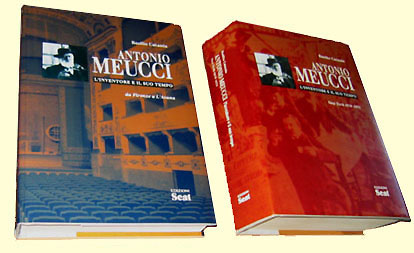
My first two-volume book "Antonio Meucci, l'inventore e il suo tempo" ("Antonio Meucci, the Inventor and His Times")
I managed to get the Quadrato della Radio and the Fondazione Marconi (the latter presided by Prof. Giancarlo Corazza, also a founder of the Quadrato della Radio) jointly organize an "International Meeting on Telephone Pioneers," to take place in the prestigious Lyncei Academy in Rome on 1 June 1994. I also managed to get four prestigious lecturers from abroad, both to present a contribution on their fellow inventors and to sound their opinion about the new evidence on Meucci that I was going to disclose. Hopefully, they could also circulate these ideas in their own countries. They were:
I gave a lecture, in Italian [19], in which I disclosed the outstanding conclusions coming from Lemmi's Affidavit and illustrated in some detail the content of my book. The Lyncei Academy provided simultaneous translation from Italian into French and English and vice versa. The meeting was attended by most of the key people of the Italian Telecommunications, as well as by many personalities of the Roman elite and a number of foreign personalities, including officers from the U.S., French and Cuban Embassies in Rome. I concluded my speech as follows (translation from Italian): "I should like to point out two principles that have inspired me in the accomplishment of this research: first, not to indulge in the obstinate search of the sole and unique inventor, to worship at the monotheistic altars of science; second, that, at the threshold of the Second Millennium, we should enter a new era of our civilization: an era that does not recognize national boundaries other than those of the human species, in every part of the globe and in every epoch of our history." I was obviously—but naively—inviting on one side the Americans not to stick to their proverbial nationalism and refuse to accept the new evidence on Meucci, but also, on the other hand, the Italians not to indulge in their proverbial xenophilia, with much the same result. This statement was, happily, fully in line with Dr. Chynoweth's, as quoted below.
All lecturers kindly spent a few words of appreciation of Meucci's work. Alan Chynoweth, however, added highly gratifying statements, even more so, as they came from the lips of a respected scientist of BellCore, a company reporting to AT&T. He stated, among other: ". . . When one compares the diagrams of the devices used by Bell and by Meucci, it is difficult not to be persuaded that Meucci’s was very similar and ought to have worked in much the same way. And with the benefit of hindsight, it is hard to swallow Judge Wallace’s technical conclusion in the famous patent case. Certainly, it seems to this reader that Meucci had something much more than the “Lover’s telephone”, two tin cans connected by a string, which is how the Judge described Meucci’s invention . . . . .From what is now known about Meucci’s work it seems very appropriate to regard him as truly one of the telephone pioneers whose achievements have too long been overshadowed by those of Bell and others. It would seem that he was a victim of the phenomenon of almost simultaneous invention, but if so, he was in very good company."
In conclusion, the meeting at the Lyncei Academy had all the attributes to go down to history. Instead, it marked the beginning of an endless series of disappointments and troubles that seriously hampered the prosecution of my research. First, no publicity of this meeting was given in any media, despite the attendance of so many important persons, normally hunting for publicity in any possible occasion. Second, the publication of the conference proceedings was canceled. Shortly after, the publication of my book was stopped. I never knew who was behind those decisions (and Dr. Principe told me "you'll never know . . ."). As for my book (see details in "Antonio Meucci—The Inventor and His Times") although volumes 1 and 2 of my book, in Italian, had been published and the English translation of both volumes had been completed, they had to be followed by two more volumes and a compact disc. An English issue of the whole work was also planned. All these issues were canceled, in violation of my contract with the publisher, After several years of dispute, on 2 March 1999, my lawyers obtained that the copyright of the entire work be returned to me, in addition to a compensation for damages and legal expenses.
Thereafter, however, I could not find an alternative publisher and this is why I recently (year 2010) resolved to post the printed material in Internet, to let a larger audience enjoy it freely.
Dr. Silvestri (left) and Dr. Clementi (right) unveil tablet at Meucci's birth house |
|
TABLET Telecom operators Guido Clementi (see diary)
one
Peruse once more all the documentary material in my possession, in search of other possible "not yet invented techniques" that Meucci might have anticipated, as he did with the inductive load.
My star was still rising
__________________________________
[1] Respighi, L., Per la priorità di Antonio Meucci nell’invenzione del telefono, CNR, Rome, 1930. Second Edition: Luigi
Respighi, Il Telefono e la Priorità di
Antonio Meucci, Edizioni Italiane, Rome, 1939. This book was based on
research by Moncada, who had died prematurely on November 20, 1933. His
original 215-page typescript, titled Antonio
Meucci, L’Inventore del Telefono, dated April 15, 1933 is now kept at the Staten Island Historical Society, 441 Clarke Avenue, Staten Island, NY.
Moncada, however, managed to publish a short paper, summarizing his findings: Antonio Meucci Inventor of the Telephone,
Atlantica, Vol. 13, No. 5, August 1932, p. 201-204.
[2] Rossi, C., Dalla rana di Galvani al volo muscolare (From Galvani’s frog to muscular flight), U. Hoepli Publisher, Milan, 1940.
[3] Editorial
Office of ‘The Chicago Tribune’, Telephone
Patents - The Application to Use the Name of the United States in a Suit
against Bell - A Promising Movement to Annul the Patent and Break the Great
Monopoly - The Claim of Antonio Meucci - Sketches and Illustrations of the
Inventor’s Instruments, The Chicago Tribune, Monday, November 9, 1885, p.
3.
[4] Winwar, F.
(Pulitzer Prize), The Monument in Staten Island: Meucci,
Garibaldi and the Telephone, E. Clemente & Sons Editors, Chicago, IL,
1957.
[5] Opinion by Judge Wallace, William J. in the case of
American Bell Telephone Co. et al. vs Globe Telephone Co. et al., rendered July
19, 1887, The Federal Reporter, 31 F. 729.
[6] "Bell" stays for "The American Bell Telephone Company" and "Globe" stays for "The Globe
Telephone Company," who acquired Meucci’s rights on the telephone.
[7] Schiavo, G. E., Antonio
Meucci, Inventor of the Telephone, The Vigo Press, New York City, NY, 1958.
[8] Catania, B., The U.S. Government Versus Alexander Graham Bell: An
Important Acknowledgment for Antonio Meucci, Bulletin of
Science, Technology & Society, Vol. 22, No. 6, December 2002, pp. 426-442.
[9] Letter from
Hon. Lamar, L. Q. C., Secretary of the Interior, to Hon. John Goode, Acting Attorney General, dated January 14,
1886, National Archives and Record Administration, College Park, MD, RG 60, DJ
6921-1885, No. 479 of 1886.
[10] The American Bell Telephone Co. et al. vs. The Globe Telephone Co. et al., National Archives and Records Administration, Northeast Region, New York, NY. Printed volumes are also available at the New York Public Library, Annex.
[11] Affidavit of Michael Lemmi (Translation of Meucci’s Memorandum book), sworn September 28 1885, National Archives and Records Administration, College Park, MD, RG 60, Department of Justice, Year Files Enclosures 1885-6921, Box 10, Folder 1, 230/3/46/6 (originally filed in RG 48, Department of the Interior, file 4513-1885, Enclosure 2).
[12] Pupin, M. I., Art of reducing attenuation of electrical waves and apparatus therefore, US Patent 652,230, filed December 1899, granted 19 June 1900; Pupin, M. I., Method of reducing attenuation of electrical waves and apparatus therefore, US Patent 652,231, filed December 1899, granted 19 June 1900.
[13] Argument of James J. Storrow: The Meucci defense and its falsity, "American Telephone Co. et al. vs. National Improved Telephone Co. et al.," Records of the US Circuit Court for the Eastern District of Louisiana, National Archives and Records Administration, College Park, MD.
[14] Affidavit of Charles R. Cross, Records of the U.S. Cir¬cuit Court for the Southern District of New York, "The American Bell Telephone Co. et al. vs. The Globe Telephone Co. et al. - “Deposition of Charles Cross, Exhibits and Affidavits,” National Archives & Records Administration, Northeast Region, New York, NY.
[15] Deposition of Antonio Meucci, Defendant’s Exhibit No. 120: Affidavit of Antonio Meucci, sworn 9 October 1885. Records of the US Circuit Court for the Southern District of New York, “The American Bell Telephone Co. et al. vs. The Globe Telephone Co. et al.,” National Archives and Records Administration, Northeast Region, New York, NY.
[16] Catania, B., Alla ricerca della verità su Antonio Meucci e sulla invenzione del telefono (“In search of the truth on Antonio Meucci and the invention of the telephone”), L’Elettrotecnica, Vol. LXXVII, No. 10, October 1990, p. 49-55, and:
[17]Catania, B., Sulle tracce di Antonio Meucci - Appunti di viaggio (“On the tracks of Antonio Meucci—Trip Notes”), L’Elettrotecnica, Vol. LXXIX, No. 10, October 1992, p. 973-984, I never credited Meucci as the inventor of the telephone.
[18] Catania, B., Antonio Meucci - L’Inventore e il suo Tempo - Da Firenze a L’Avana (Vol. 1) (“Antonio Meucci, The Inventor and His Times—From Florence to Havana (Vol. 1)”), Seat - Divisione STET, Editoria per la Comunicazione, Roma, 1994; Antonio Meucci - L’Inventore e il suo Tempo - New York 1850-1871 (Vol. 2) (“Antonio Meucci, The Inventor and His Times—New York 1850-1871 (Vol. 2)”), Seat - Divisione STET, Torino, 1996
[19] Catania, B., Lecture at the International Conference on the Telephone Pioneers [in Italian], organized by the "Quadrato della Radio" and "Fondazione Marconi," Rome, Accademia dei Lincei, 1 June 1994.
[20] Catania, B., Un documento inedito rivaluta l’opera di Antonio Meucci (“An unpublished document revalues the achievements of Antonio Meucci”), AEI - Automazione, Energia, Informazione, Vol. 82, No. 2, February 1995, p. 32-40.
[21] Catania, B., Antonio Meucci: un grande italiano da rilanciare in campo internazionale (“Antonio Meucci, a great Italian to be relaunched internationally”), Lecture at the Italian Electrical Association (AEI), Milan, 27 March 1995.
[22] Catania, B., Antonio Meucci - L’Inventore e il suo tempo (“Antonio Meucci—The Inventor and His Times”), Lecture at Palazzo Vecchio - Salone dei Gigli, Florence, 16 May 1996.
[23] Catania, B., La labor precursora de Antonio Meucci sobre el teléfono desde La Habana hasta Clifton ("Antonio Meucci's pioneering work on the telephone, from Havana to Clifton"), Revista Bimestre Cubana, La Habana, Vol. LXXIX, Época III, No. 4, January-June 1996, p. 49-63.
[24] Catania, B., Antonio Meucci Revisited, Antenna, Newsletter of the Mercurians, in the Society for the History of Technology, Denver, CO (USA) Vol. 9, No. 1, November 1996, p. 4-5.
Catania, B., Il Governo degli Stati Uniti contro Alexander Graham Bell - Un importante riconoscimento per Antonio Meucci, AEI - Automazione, Energia, Informazione, Vol. 86, Supplemento al N. 10, ottobre 1999, pp. 1-12
Catania, B., El Gobierno de los Estados Unidos contra Alexander Graham Bell: Un importante reconocimiento para Antonio Meucci, in: Altshuler, J., Díaz Martín, R. (Editors) Primeros Experimentos Telefónicos de Antonio Meucci – La Habana 1849-1999 (Aniversario 150), Sociedad Cubana de Historia de la Ciencia y la Tecnología, diciembre 1999 (p. 155-184)
Catania, B., Four ‘Firsts’ in Telephony (invited paper), ETT-European Transactions on Telecommunications, Vol. 10, No. 6, November-December 1999, pp. 681-687
Catania, B., The United States Government versus Alexander Graham Bell - An important acknowledgment for Antonio Meucci, traduzione di F. Ricciardi, distribuita in occasione del 150° Anniversario dell’arrivo di Antonio Meucci a New York, il 1 maggio 2000, insieme allo speciale annullamento postale della busta celebrativa.
![]() made with Adobe Dreamweaver®
made with Adobe Dreamweaver®
Date last modified: 18 August 2010
![]()